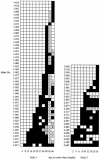Genetic diversity and carriage dynamics of Neisseria lactamica in infants
- PMID: 15784588
- PMCID: PMC1087434
- DOI: 10.1128/IAI.73.4.2424-2432.2005
Genetic diversity and carriage dynamics of Neisseria lactamica in infants
Abstract
Neisseria lactamica, a harmless human commensal found predominantly in the upper respiratory tracts of infants, is closely related to Neisseria meningitidis, a pathogen of global significance. Colonization with N. lactamica may be responsible for the increase in immunity to meningococcal disease that occurs during childhood, when rates of meningococcal carriage are low. This observation has led to the suggestion that N. lactamica whole cells or components are potential constituents of novel meningococcal vaccines. However, the dynamics of carriage and population diversity of N. lactamica in children are poorly understood, presenting difficulties for the choice of representative isolates for use in vaccine development. This problem was addressed by the multilocus sequence typing of N. lactamica isolates from two longitudinal studies of bacterial carriage in infants. The studies comprised 100 and 216 subjects, with N. lactamica carriage monitored from age 4 weeks until age 96 weeks and from age 2 weeks until age 24 weeks, respectively. The maximum observed carriage rate was 44% at 56 weeks of age, with isolates obtained on multiple visits for the majority (54 of 75, 72%) of carriers. The N. lactamica isolates were genetically diverse, with 69 distinct genotypes recovered from the 75 infants. Carriage was generally long-lived, with an average rate of loss of under 1% per week during the 28 weeks following acquisition. Only 11 of the 75 infants carried more than one genotypically unique isolate during the course of the study. Some participants shared identical isolates with siblings, but none shared identical isolates with their parents. These findings have implications for the design of vaccines based on this organism.
Figures


References
-
- Blakebrough, I. S., B. M. Greenwood, H. C. Whittle, A. K. Bradley, and H. M. Gilles. 1982. The epidemiology of infections due to Neisseria meningitidis and Neisseria lactamica in a northern Nigerian community. J. Infect. Dis. 146:626-637. - PubMed
-
- Borrow, R., D. Goldblatt, A. Finn, J. Southern, L. Ashton, N. Andrews, G. Lal, C. Riley, R. Rahim, K. Cartwright, G. Allan, and E. Miller. 2003. Immunogenicity of, and immunologic memory to, a reduced primary schedule of meningococcal C-tetanus toxoid conjugate vaccine in infants in the United kingdom. Infect. Immun. 71:5549-5555. - PMC - PubMed
-
- Bowler, L. D., Q. Y. Zhang, J. Y. Riou, and B. G. Spratt. 1994. Interspecies recombination between the penA genes of Neisseria meningitidis and commensal Neisseria species during the emergence of penicillin resistance in N. meningitidis: natural events and laboratory simulation. J. Bacteriol. 176:333-337. - PMC - PubMed
Publication types
MeSH terms
Substances
LinkOut - more resources
Full Text Sources
Other Literature Sources

